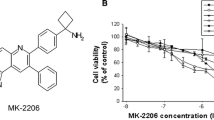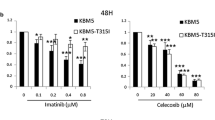Abstract
Chronic myeloid leukemia (CML) is a cancer type of the white blood cells and because of BCR-ABL translocation it results in increased tyrosine kinase activity. For this purpose, dasatinib is the second-generation tyrosine kinase inhibitor that is used for inhibition of BCR-ABL. Effectively and safetly, dasatinib has been used for imatinib-intolerant/resistant CML patients. Protein phosphatase 2A (PP2A) is the major serine/threonine phosphatase ensuring cellular homeostasis in cells and is associated with many cancer types including leukemias. In this study, we aimed to investigate the effects of dasatinib and okadaic acid (OA), either alone or in combination, on apoptosis and cell cycle arrest and dasatinib effect on enzyme activity and protein-level changes of PP2A in K562 cell line. The cytotoxic effects of dasatinib were evaluated by WST-1 analysis. Apoptosis was determined by Annexin V and Apo-Direct assays by flow cytometry. Cell cycle arrest analysis was performed for the investigation of the cytostatic effect. We also used OA as a PP2A inhibitor to assess apoptosis and cell cycle arrest changes in case of reducing the level of PP2A. PP2A enyzme activity and protein levels of PP2A were examined by serine/threonine phosphatase assay and Western blot analysis, respectively. Apoptosis was increased with dasatinib and OA combination. Cell cycle arrest was determined especially after OA treatment. The enzyme activity was decreased depending on time after dasatinib application. PP2A regulatory and catalytic subunit protein levels were decreased compared to control. Targeting the PP2A by dasatinib and OA has potential for CML treatment.






Similar content being viewed by others
Abbreviations
- CML:
-
Chronic myeloid leukemia
- Das:
-
Dasatinib
- OA:
-
Okadaic acid
- TKI:
-
Tyrosine kinase inhibitor
- WST-1:
-
Water soluble tetrazolium-1
- CP:
-
Chronic phase
- AP:
-
Accelerated phase
- IC50 :
-
Inhibitory concentration 50%
- FBS:
-
Fetal bovine serum
- DMSO:
-
Dimethyl sulfoxide
- FITC:
-
Fluorescein isothiocyanate
- PI:
-
Propidium iodide
- PBS:
-
Phosphate-buffered saline
References
Hochhaus A, Larson RA, Guilhot F, Radich JP, Branford S, Hughes TP, Baccarani M, Deininger MW, Cervantes F, Fujihara S, et al. Long-term outcomes of imatinib treatment for chronic myeloid leukemia. N Engl J Med. 2017;376(10):917–27.
Carter BZ, Mak PY, Mu H, Zhou H, Mak DH, Schober W, Leverson JD, Zhang B, Bhatia R, Huang X, et al. Combined targeting of BCL-2 and BCR-ABL tyrosine kinase eradicates chronic myeloid leukemia stem cells. Sci Transl Med. 2016;8(355):355ra117. https://doi.org/10.1126/scitranslmed.aag1180.
Aguilera DG, Tsimberidou AM. Dasatinib in chronic myeloid leukemia: a review. Ther Clin Risk Manag. 2009;5:281–9. https://doi.org/10.2147/tcrm.s3425.
McCafferty EH, Dhillon S, Deeks ED. Dasatinib: a review in pediatric chronic myeloid leukemia, pediatr. Drugs. Pediatric Drugs. 2018;20(6):593–600. https://doi.org/10.1007/s40272-018-0319-8.
Rix U, Hantschel O, Dürnberger G, Rix LLR, Planyavsky M, Fernbach NV, Kaupe I, Bennett KL, Valent P, Colinge J, et al. Chemical proteomic profiles of the BCR-ABL inhibitors imatinib, nilotinib, and dasatinib reveal novel kinase and nonkinase targets. Blood. 2007;110(12):4055–63. https://doi.org/10.1182/blood-2007-07-102061.
Steinberg M. A tyrosine kinase inhibitor for the treatment of chronic myelogenous leukemia and philadelphia chromosome-positive acute lymphoblastic leukemia. Clin Ther. 2007;29(11):2289–308. https://doi.org/10.1016/j.clinthera.2007.11.005.
Jabbour EJ, Cortes JE, Kantarjian HM. Resistance to tyrosine kinase inhibition therapy for chronic myelogenous leukemia: a clinical perspective and emerging treatment options. Clin Lymphoma Myeloma Leuk. 2013;13(5):515–29. https://doi.org/10.1016/j.clml.2013.03.018.
Bauman AL, Scott JD. Kinase- and phosphatase-anchoring proteins: harnessing the dynamic duo. Nat Cell Biol. 2002;4(8):E203–6. https://doi.org/10.1038/ncb0802-e203.
Zhang L, Zhou H, Li X, Vartuli RL, Rowse M, Xing Y, Rudra P, Ghosh D, Zhao R, Ford HL. Eya3 partners with PP2A to induce c-Myc stabilization and tumor progression. Nat Commun. 2018;9(1):1047. https://doi.org/10.1038/s41467-018-03327-4.
Pippa R, Odero MD. The role of MYC and PP2A in the initiation and progression of myeloid leukemias. Cells. 2020;9(3):544. https://doi.org/10.3390/cells9030544.
Shi Y. Serine/threonine phosphatases: mechanism through structure. Cell. 2009;139(3):468–84. https://doi.org/10.1016/j.cell.2009.10.006.
Raman D, Pervaiz S. Redox inhibition of protein phosphatase PP2A: potential implications in oncogenesis and its progression. Redox Biol. 2019;27:101105. https://doi.org/10.1016/j.redox.2019.101105.
Perrotti D, Neviani P. Protein phosphatase 2A: a target for anticancer therapy. Lancet Oncol. 2013;14(6):e229–38. https://doi.org/10.1016/S1470-2045(12)70558-2.
Seshacharyulu P, Pandey P, Datta K, Batra SK. Phosphatase: PP2A structural importance, regulation and its aberrant expression in cancer. Cancer Lett. 2013;335(1):9–18. https://doi.org/10.1016/j.canlet.2013.02.036.
Haesen D, Sents W, Lemaire K, Hoorne Y, Janssens V. The basic biology of PP2A in hematologic cells and malignancies. Front Oncol. 2014;4:347. https://doi.org/10.3389/fonc.2014.00347.
Sangodkar J, Farrington CC, Mcclinch K, Galsky MD, Kastrinsky DB, Narla G. All roads lead to PP2A: exploiting the therapeutic potential of this phosphatase this phosphatase. FEBS J. 2016;283(6):1004–24. https://doi.org/10.1111/febs.13573.
Perrotti D, Jamieson C, Goldman J, Skorski T. Chronic myeloid leukemia: mechanisms of blastic transformation. J Clin Invest. 2010;120(7):2254–64. https://doi.org/10.1172/JCI41246.
Woessner DW, Lim CS, Deininger MW. Development of an effective therapy for CML. Cancer J. 2011;17(6):477–86. https://doi.org/10.1097/PPO.0b013e318237e5b7.
Shah NP, García-Gutiérrez V, Jiménez-Velasco A, Larson S, Saussele S, Rea D, Mahon FX, Levy MY, Gómez-Casares MT, Pane F, et al. Dasatinib discontinuation in patients with chronic-phase chronic myeloid leukemia and stable deep molecular response: the DASFREE study. Leuk Lymphoma. 2020;61:650–9. https://doi.org/10.1080/10428194.2019.1675879.
Schweyer S, Bachem A, Bremmer F, Steinfelder HJ, Soruri A, Wagner W, Pottek T, Thelen P, Hopker WW, Radzun HJ, et al. Expression and function of protein phosphatase PP2A in malignant testicular germ cell tumours. J Pathol. 2007;213:72–81. https://doi.org/10.1002/path.2203.
Lai D, Chen M, Su J, Liu X, Rothe K, Hu K, Forrest DL. Eaves CJ, Morin GB, Jiang X. Response to Comment on PP2A inhibition sensitizes cancer stem cells to ABL tyrosine kinase inhibitors in BCR-ABL+ human leukemia. Sci Transl Med. 2019;11(501):eaav0819. https://doi.org/10.1126/scitranslmed.aav0819.
Hong CS, Ho W, Zhang C, Yang C, Elder JB, Zhuang Z. LB100, a small molecule inhibitor of PP2A with potent chemo- and radio-sensitizing potential. Cancer Biol Ther. 2015;16:821–33. https://doi.org/10.1080/15384047.2015.1040961.
Kiely M, Kiely PA. PP2A: the wolf in sheep’s clothing? Cancers (Basel). 2015;7(2):648–69. https://doi.org/10.3390/cancers7020648.
Hu C, Yu M, Ren Y, Li K, Maggio DM, Mei C, Ye L, Wei J, Jin J, Zhuang Z, et al. PP2A inhibition from LB100 therapy enhances daunorubicin cytotoxicity in secondary acute myeloid leukemia via miR-181b-1 upregulation. Sci Rep. 2017;7:2894. https://doi.org/10.1038/s41598-017-03058-4.
Riordan FA, Foroni L, Hoffbrand AV, Mehta AB, Wickremasinghe RG. Okadaic acid-induced apoptosis of HL60 leukemia cells is preceded by destabilization of bcl-2 mRNA and downregulation of bcl-2 protein. FEBS Lett. 1998;435(2–3):195–8. https://doi.org/10.1016/s0014-5793(98)01070-9.
Benito A, Lerga A, Silva M, Leon J, Fernandez-Luna JL. Apoptosis of human myeloid leukemia cells induced by an inhibitor of protein phosphatases (okadaic acid) is prevented by Bcl-2 and Bcl-XL. Leukemia. 1997;11:940–4.
Gong FR, Wu MY, Shen M, Zhi Q, Xu ZK, Wang R, Wang WJ, Zong Y, Li ZL, Wu Y, et al. PP2A inhibitors arrest G2/M transition through JNK/Sp1-dependent down-regulation of CDK1 and autophagy-dependent up-regulation of p21. Oncotarget. 2015;6(21):18469–83. https://doi.org/10.18632/oncotarget.4063.
Taylor BK, Stoops TD, Everett AD. Protein phosphatase inhibitors arrest cell cycle and reduce branching morphogenesis in fetal rat lung cultures. Am J Physiol Lung Cell Mol Physiol. 2000;278(5):L1062–70. https://doi.org/10.1152/ajplung.2000.278.5.L1062.
Li W, Xie L, Chen Z, Zhu Y, Sun Y, Miao Y, Xu Z, Han X. Cantharidin, a potent and selective PP2A inhibitor, induces an oxidative stress-independent growth inhibition of pancreatic cancer cells through G2/M cell-cycle arrest and apoptosis. Cancer Sci. 2010;101:1226–33. https://doi.org/10.1111/j.1349-7006.2010.01523.x.
Lu J, Kovach JS, Johnson F, Chiang J, Hodes R, Lonser R, Zhuang Z. Inhibition of serine/threonine phosphatase PP2A enhances cancer chemotherapy by blocking DNA damage induced defense mechanisms. Proc Natl Acad Sci USA. 2009;106:11697–702. https://doi.org/10.1073/pnas.0905930106.
Sallman DA, Wei S, List A. PP2A: the achilles heal in MDS with 5q deletion. Front Oncol. 2014;4:264. https://doi.org/10.3389/fonc.2014.00264..
Duong FHT, Dill MT, Matter MS, Makowska Z, Calabrese D, Dietsche T, Ketterer S, Terracciano L, Heim MH. Protein phosphatase 2A promotes hepatocellular carcinogenesis in the diethylnitrosamine mouse model through inhibition of p53. Carcinogenesis. 2014;35(1):114–22. https://doi.org/10.1093/carcin/bgt258.
Acknowledgements
None.
Funding
This study was financially supported by Ege University Scientific Research Projects Fund (BAP) which is Grant Number 2015-TIP-007.
Author information
Authors and Affiliations
Contributions
Conceptualization; BO, NSG, and GS. Material preparation, data collection, and investigation; BO, SK, and CA. Data analysis and interpretation; BO, CBA, and CG. Writing the manuscript; BO. All authors read and approved the final manuscript.
Corresponding author
Ethics declarations
Conflict of ınterest
No potential conflict of interest was reported by the authors.
Additional information
Publisher's Note
Springer Nature remains neutral with regard to jurisdictional claims in published maps and institutional affiliations.
Rights and permissions
About this article
Cite this article
Ozel, B., Kipcak, S., Biray Avci, C. et al. Combination of dasatinib and okadaic acid induces apoptosis and cell cycle arrest by targeting protein phosphatase PP2A in chronic myeloid leukemia cells. Med Oncol 39, 46 (2022). https://doi.org/10.1007/s12032-021-01643-2
Received:
Accepted:
Published:
DOI: https://doi.org/10.1007/s12032-021-01643-2




